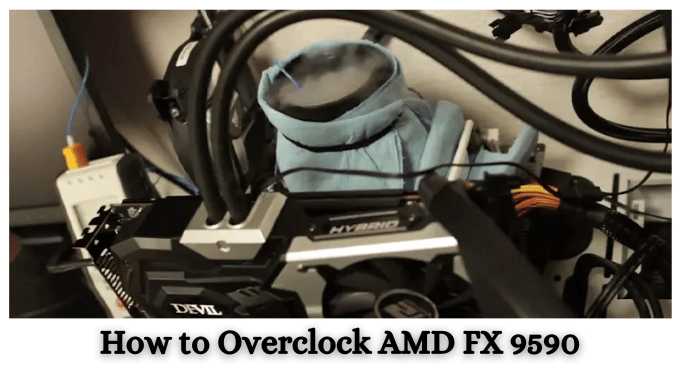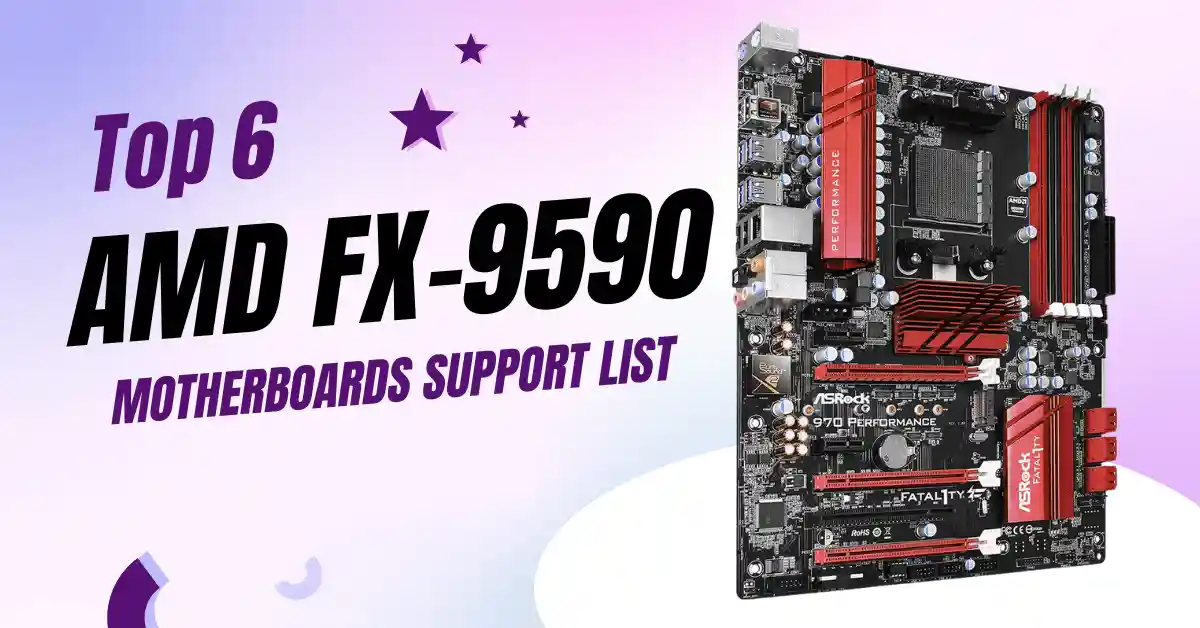Lets see How to Overclock AMD FX 9590? The AMD FX 9590 can run faster than its default settings by overclocking and improving performance. If the CPU is the problem, overclocking can be successful.
The FX-9590 can be overclocked from its 5GHz maximum stock speed up to 5GHz overclock using a motherboard with the NVIDIA GeForce 7025 / nForce 630a chipset. A system becomes unstable if that threshold is exceeded. With the RTX 2070 at 1080p – ultra settings, the performance increase ranged from 0.5% at the maximum to 0.2% at the minimum.
There are various methods for doing this, including physically modifying the CPU’s clock speed through the computer’s BIOS or using a BIOS utility, software-based overclocking tools, or both.
Preparing Your PC for Overclocking
Determine the Desired Clock Speed
The clock speed users want their AMD FX 9590 CPU to run should be chosen before they start overclocking. Finding a prosperous, stable speed achievable and safe for the system’s components can be done by looking up previous overclocking attempts on hardware similar to the hardware in question.
Prepare the System
Users must get their machine ready for overclocking after choosing a clock speed. It ensures that equipment like the cooling system and power supply is current and enough for the work. It’s crucial to back up any vital information in case something goes wrong while the process is underway.
Adjust BIOS Settings
Users must modify the computer’s Basic Input/Output System (BIOS) settings after the system is prepared to allow overclocking. It involves adjusting the processor, memory, and other component voltages and raising the multipliers or base clocks.
Test Results
It’s crucial to test the effects after making BIOS configuration adjustments. Benchmark programs or stress tests can be used to determine how effectively the system is functioning and whether any stability issues are present.
Monitoring Tools
Users should use monitoring tools that keep track of temperature, voltage, and other overclocking-related aspects to keep tabs on how their systems are doing.
Troubleshooting
Troubleshooting should be conducted to locate and address any issues that may develop with stability or performance while overclocking. It can entail returning to earlier BIOS configurations, switching cooling options, or resetting default voltage levels.
Overclocking Safety
Users must always remember to take safety precautions when overclocking. The manufacturer’s instructions should be followed, and each component should be handled gently. Users should also utilize an ESD wrist strap or anti-static mat before installing hardware to avoid electrostatic discharge (ESD) hazards.
It is advisable to exercise caution and carry out the process gradually, making minor incremental modifications to core voltage, frequency, and cooling solutions. Overclocking is, by nature, a risky hobby. Users may guarantee system stability and achieve the most significant performance advantages with this method.
Setting the Clock Frequency and Voltage
Users can modify their components’ voltage and clock frequency once the system is overclocked. Although they all carry out identical tasks, each motherboard’s software for changing these values will differ significantly. The “CPU Multiplier” or “Clock Frequency” settings on the primary sliders are often raised to speed up the CPU. The grounds are typically displayed on motherboards in either MHz or GHz.
The voltage setting is typically made to match the CPU speed setting and is another essential overclocking aspect. It’s crucial to exercise caution when making these modifications because modifying this number could harm hardware if not handled appropriately. Some motherboards include “Automatic Voltage Settings,” which, by delivering safe voltage levels for each clock frequency setting, can help lower the possibility of hardware damage.
The last step is for users to confirm their settings after the numbers have been set and ensure nothing is overheating or malfunctioning. Users can do this by running stress tests or benchmarking software to ensure everything is functioning. If everything is in order, the user can begin utilizing their overclocked CPU for the purpose they intended it for and enjoy an enhanced performance.
Testing Stability and Monitoring Temperatures
It’s critical to assess system stability and monitor temperature levels for customers who are overclocking their CPUs. A stress test or benchmarking program can be used to check that the overclocked settings are stable and won’t harm the hardware.
Users should also monitor their temperatures to ensure that their CPU isn’t operating too hotly, as this could physically damage the components. Users must decrease clock speeds to safeguard their hardware if temperatures get too high.
Fine-Tuning and Optimizing Performance
Users might additionally wish to evaluate stability and the ideal temperature and performance trade-off. It can be accomplished by adjusting several BIOS parameters, such as the CPU voltage or memory speeds.
By doing this, users can get the most out of their technology while ensuring that temperatures stay within acceptable ranges. Various third-party programs are readily available to users to aid with performance optimization and hardware setting discovery. Users may ensure their system is operating at its peak performance using the appropriate strategy and tools.
Finally, it’s important to note that overclocking a CPU or GPU might void the hardware warranty. Therefore only experienced users who are aware of the hazards should do it. Users can safely overclock their gear and gain better performance by heeding these recommendations and doing stability tests.
How to Overclock?
Using a BIOS Utility
- Restart your computer and press “F2” when prompted to enter the BIOS.
- Find the CPU menu option, typically located under a category called “Advanced.”
- Keep an eye out for choices like “CPU Clock Ratio,” which lets you change the CPU’s clock speed.
- Boost the ratio by one or two steps and save your adjustments before shutting off the BIOS program.
Using Software-Based Overclocking Tools
- Download and install a software-based overclocking program, such as AMD OverDrive or Intel Extreme Tuning Utility.
- Launch the program, then modify the settings to raise the CPU’s voltage, clock speed, and other parameters by the options available on the interface.
- Use an application for benchmarking, such as 3DMark, Prime95, or Cinebench R15, to check the stability of your new configuration.
- Restart your computer after adjusting the hardware settings in the BIOS to match what you set in the software-based overclocking tool.
- Retest your configuration to see whether it performs better and compare the results. If not, return to the options menu and make necessary changes until the desired performance level is achieved.
- If you are happy with your overclock, save the settings to a profile and use them frequently.
- Make use of the monitoring features of Intel Extreme Tuning Utility by keeping an eye on temperatures, voltages, clock speeds, and other real-time metrics to spot and address any potential stability concerns.
- Finally, update your system’s drivers and operating system frequently to guarantee that your overclock stays secure and stable.
You can utilize overclocking to maximize performance while maintaining the dependability and safety of your computer with regular monitoring and adjusting.
Overclocking can increase performance, but stability and security must be ensured by following the essential safety measures. Utilize Intel Extreme Tuning Utility or other overclocking tools while considering the danger concerns, and then change your settings as necessary. Track temperatures, voltages, clock speeds, and environments using monitoring functions. To preserve performance and stability, update your system’s operating system and drivers frequently. You can benefit from overclocking while maintaining the integrity of your machine with careful maintenance.
By following these instructions, you ought to maximize the use of your PC while maintaining its safety and security.
Conclusion
Overclocking has some obvious drawbacks, such as the potential to void your warranty whenever you use an Intel processor outside of its design parameters. If you overclock incorrectly, premature failure and a shorter CPU lifespan can also occur. You can reduce these risks by adhering to the correct settings and configurations.
See From Us
FAQs
How can my AMD FX 6300 be overclocked?
The AMD FX 6300 overclocking procedure is the same as the other FX series processors. It is preferable to purchase and install a water cooler system in your system to prevent overheating.
Can you play games on the AMD FX 9590?
The AMD FX 9590 is an old graphics card with a bad reputation for overheating. You’ll need help running recently released games on the platform, even at lower settings, because it is outdated for the current market. When overclocked, it performs admirably in games, comparable to an i3-6100.
How much AMD FX 8350 overclocking is possible?
Despite being an old processor, the AMD FX 8350 has eight cores and threads and a base clock speed of 4GHz, making it a powerful enough CPU. The FX 8350 CPU can easily be overclocked with an air cooler to 4.2 GHz. You can increase the speed to around 4.8 GHz with liquid cooling.










